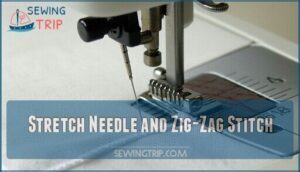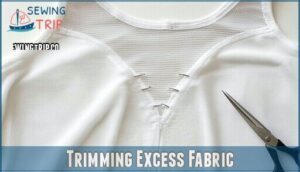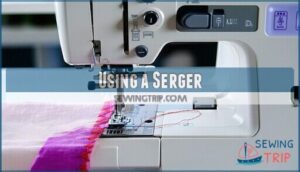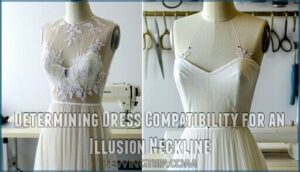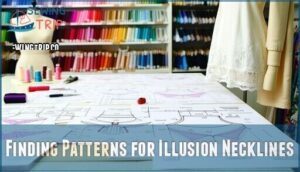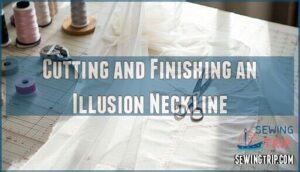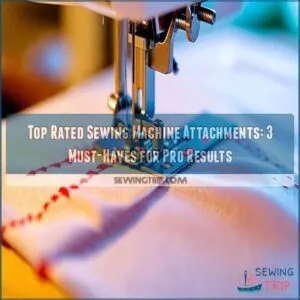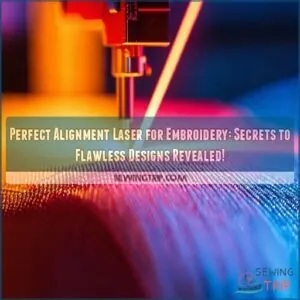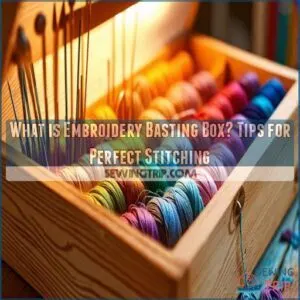This site is supported by our readers. We may earn a commission, at no cost to you, if you purchase through links.
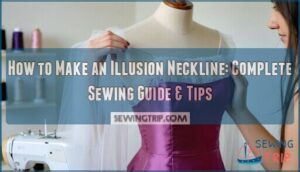 Creating an illusion neckline transforms ordinary dresses into sophisticated showstoppers by layering sheer fabric over the existing neckline.
Creating an illusion neckline transforms ordinary dresses into sophisticated showstoppers by layering sheer fabric over the existing neckline.
You’ll need translucent materials like tulle, mesh, or lace that match your skin tone. Start by cutting the illusion fabric slightly larger than needed, then attach it using a stretch needle and zigzag stitch to prevent puckering.
The key lies in precise trimming and proper tension—too tight creates pulling, too loose looks sloppy. Position the fabric so it lies flat against your skin, creating that coveted "floating" effect.
Master this technique, and you’ll discover secrets for adding beading, creating complex designs, and achieving professional-quality results.
Table Of Contents
- Key Takeaways
- What is an Illusion Neckline?
- Fabric Choices for an Illusion Neckline
- Sewing Techniques for Illusion Fabric
- Determining Dress Compatibility for an Illusion Neckline
- Adding Beading to an Illusion Neckline
- Creating Complex Designs With Illusion Fabric
- Finding Patterns for Illusion Necklines
- Adding an Illusion Neckline to a Wedding Dress
- Cutting and Finishing an Illusion Neckline
- Addressing Common Concerns and Solutions
- Frequently Asked Questions (FAQs)
- Conclusion
Key Takeaways
- Choose the right fabric for your project – You’ll want skin-tone matching tulle, mesh, or lace that’s lightweight enough to create that floating effect without weighing down your neckline.
- Master essential sewing techniques – Use a 75/11 stretch needle with zigzag stitches set to 2.0mm length and 1.5mm width to prevent puckering and maintain the fabric’s natural give.
- Perfect your trimming and finishing – Cut excess fabric with sharp scissors, leaving a quarter-inch seam allowance, and make small perpendicular clips on curves to prevent bunching when the fabric follows your body’s contours.
- Test compatibility before committing – Ensure your dress has proper bodice support, medium-to-heavy fabric weight, and simple clean lines, since not all dress styles work well with illusion neckline modifications.
What is an Illusion Neckline?
An illusion neckline transforms your dress into something magical by creating the appearance of floating lace or embellishments against bare skin.
Transform any ordinary dress into pure magic with the enchanting illusion of floating lace that seems to dance on bare skin.
This sheer fabric technique uses materials like tulle, mesh, or fine netting to craft a "barely there" effect that’s both modest and alluring.
The concept gained momentum through Design Evolution in haute couture, where designers discovered they could balance coverage with sensuality.
Modern Styles now showcase this technique across bridal gowns, evening wear, and red carpet fashion.
Celebrity Influence has particularly boosted its popularity, with stars choosing illusion necklines for their elegant sophistication.
This neckline style works by layering transparent material over a solid base, creating depth and visual interest.
The Cultural Significance lies in its ability to honor traditional modesty while embracing contemporary fashion.
Whether you’re crafting a wedding dress or updating an existing garment, mastering illusion necklines opens up endless creative possibilities for sophisticated, eye-catching designs, using techniques like layering transparent material and showcasing elegant sophistication with a touch of haute couture and contemporary fashion.
Fabric Choices for an Illusion Neckline
The fabric you choose for your illusion neckline determines both the visual effect and comfort of your finished garment, with tulle, netting, and lace offering distinct advantages for different design goals.
Each material requires specific handling techniques and provides unique transparency levels, so you’ll need to match your fabric selection to your intended style and sewing skill level.
You’ll also want to consider how the chosen fabric will affect the overall visual effect of your garment.
Tulle
Soft tulle creates the dreamiest illusion necklines you’ll ever sew. This delicate mesh transforms ordinary necklines into ethereal masterpieces that seem to float on your skin.
Tulle’s sturdy mesh holds shape well, but can irritate skin.
- Tulle types: Choose between soft bridal tulle or structured millinery tulle for different effects
- Tulle density: Fine denier creates subtle transparency while heavier weights offer more coverage
- Tulle stiffness: Soft drape works beautifully for romantic looks, crisp tulle holds structured shapes
- Tulle colors: Match your skin tone with nude, ivory, or champagne for seamless blending
- Tulle applications: Layer multiple colors or add sparkle with glittered varieties for extra drama
Netting
While tulle offers structure, netting provides an ultra-lightweight alternative that virtually disappears against your skin.
This gossamer-thin sheer fabric creates the perfect barely-there effect for your illusion neckline project.
Key benefits of choosing netting:
- Netting Opacity – Nearly invisible transparency showcases your natural beauty
- Netting Durability – Surprisingly strong despite its delicate appearance
- Netting Types – Diamond mesh, hexagonal, and bridal varieties available
- Netting Cost – Budget-friendly option compared to premium fabrics
- Netting Alternatives – Fine tulle or organza work when netting isn’t available
For a wide selection, consider illusion netting options online.
Lace
Lace brings timeless elegance to your illusion neckline project.
Vintage lace and delicate lace appliqués create stunning focal points on sheer fabric. Choose from various lace types – from Chantilly to Alençon – each offering unique lace motifs.
Consider lace durability when selecting materials for your wedding dress, as some delicate varieties require gentle handling during sewing techniques.
| Lace Type | Best For | Emotional Impact |
|---|---|---|
| Chantilly | Romantic illusion necklines | Creates dreamy, fairy-tale feelings |
| Alençon | Formal wedding dress designs | Evokes luxury and sophistication |
| Guipure | Bold statement pieces | Inspires confidence and drama |
Sewing Techniques for Illusion Fabric
Working with illusion fabric requires specific techniques that prevent puckering and guarantee your delicate materials stay intact throughout construction.
Working with illusion fabric is like handling butterfly wings—one wrong move and your ethereal creation crumbles.
You’ll need to master stretch needles, zigzag stitching, and proper trimming methods to achieve professional results that won’t unravel or distort your neckline’s elegant appearance.
Stretch Needle and Zig-Zag Stitch
Working with delicate illusion fabric requires the right equipment to prevent disaster.
Your stretch needle (size 75/11) penetrates mesh without creating runs, while a zigzag stitch accommodates the fabric’s natural give.
Set your stitch length to 2.0mm and width to 1.5mm for ideal results.
For reliable performance, consider using a quality 75/11 needle.
Key sewing machine adjustments for illusion neckline tutorial success:
- Needle Size: Use 75/11 stretch needle for delicate fabrics
- Tension Adjustment: Reduce upper thread tension slightly to prevent puckering
- Fabric Feed: Use gentle pressure to avoid stretching the mesh
- Seam Durability: Test stitch settings on scraps before final sewing
Trimming Excess Fabric
Smart trimming transforms your illusion neckline from amateur to professional. After stitching, use sharp fabric scissors to carefully cut away excess material, leaving a quarter-inch seam allowance.
Handle delicate mesh with gentle pressure to prevent tearing during this pivotal step. For curved areas, make small clips perpendicular to the seam line—this prevents puckering when the fabric naturally follows body contours.
Proper fray prevention starts with clean, precise cuts that respect your sheer fabric’s delicate nature, ensuring a finish that looks professional.
Using a Serger
Fire up your serger to transform raw illusion fabric edges into professional perfection. This powerhouse sewing machine creates clean, durable finishes that elevate your mesh neckline sewing from amateur to expert level.
- Thread the serger with matching thread types – polyester works beautifully with delicate illusion fabrics
- Adjust serger tension settings carefully – too tight will pucker your sheer material
- Use differential feed to prevent stretching – essential for maintaining fabric integrity
- Create a rolled hem finish – gives illusion necklines that couture edge
- Navigate curved seams smoothly – let the machine guide the fabric naturally
Achieving a professional look often involves using a serger rolled hem for delicate edges.
Determining Dress Compatibility for an Illusion Neckline
Not every dress is ready for an illusion makeover. Your dress compatibility depends on several key factors that’ll make or break this delicate technique. Think of it like matchmaking – the right fabric weight, bodice support, and design complexity need to align perfectly.
| Compatibility Factor | Compatible | Incompatible |
|---|---|---|
| Dress Style | A-line, ballgown, mermaid | Halter tops, strapless mini |
| Bodice Support | Built-in boning, structured cups | Flimsy construction, backless |
| Fabric Weight | Medium to heavy fabrics | Ultra-lightweight, stretchy knits |
| Design Complexity | Simple, clean lines | Heavily embellished, multiple layers |
| Alteration Feasibility | Generous seam allowances | Tight-fitted, minimal fabric |
Your neckline design must accommodate the illusion fabric’s drape while maintaining proper skin tone coordination. Understanding neckline alteration costs is also vital for budgeting. Test your fabric selection on a small area first – this prevents costly mistakes and guarantees the transparent panel won’t sag or pucker against your body’s natural curves.
Adding Beading to an Illusion Neckline
Once you’ve confirmed your dress works well with an illusion neckline, it’s time to add some sparkle. Beading transforms plain illusion fabric into something magical, but you’ll need the right approach.
Start with Bead Types that won’t overwhelm delicate tulle or netting. Seed beads and small crystals work beautifully, while heavy glass beads can pull and distort your fabric.
Your Placement Strategy should follow the neckline’s natural curves, creating flowing patterns rather than rigid lines. Holli’s gown featured a stunning illusion neckline design.
Securing Beads requires fine beading needles and strong thread. Use backstitch or couching techniques for durability. Keep Design Complexity manageable – simple patterns often look more elegant than busy ones. Consider Bead Weight carefully; too many heavy embellishments will cause sagging.
When combining lace appliqués with beading, plan your fabric integration first. The illusion neckline should enhance, not compete with your sewing techniques.
Creating Complex Designs With Illusion Fabric
Once you’ve mastered beading techniques, you’re ready to push creative boundaries with complex illusion fabric designs. Think of your fabric as a blank canvas where geometric illusions can transform a simple neckline into architectural art.
Create striking asymmetrical designs by positioning solid fabric pieces against sheer panels, letting the contrast tell your story. Texture combinations work magic when you layer different materials.
Pair smooth satin with textured lace over nude illusion fabric for depth that catches light beautifully. Your sewing techniques should anchor these elements securely while maintaining the floating effect. One popular technique involves using a rolled hem finish for a neat edge.
Don’t shy away from avant-garde designs that challenge traditional expectations. Color experimentation opens new doors—try unexpected hues layered beneath your illusion neckline for subtle surprises. The key to successful fabric integration lies in strategic placement.
Position opaque sections to create visual interest while the sheer areas maintain that coveted barely-there appearance. Your creativity determines the final impact.
Finding Patterns for Illusion Necklines
Complex illusion designs open doors to endless pattern possibilities waiting in your sewing toolkit.
You’ll discover pattern availability spans from major brands like Simplicity and McCall’s to indie designers offering fresh digital resources.
These sewing patterns provide design variations from deep V-necks to sweetheart shapes, each with customization options for your skill level.
- Commercial patterns give you tried-and-true foundations for neckline patterns
- Etsy’s PDF downloads deliver instant gratification for your creative projects
- Pattern modification transforms basic dress patterns into stunning illusion masterpieces
- Local fabric shops house hidden gems in their pattern books
- Custom services create made-to-measure patterns fitting your exact measurements
Adding an Illusion Neckline to a Wedding Dress
Now that you’ve chosen your pattern, let’s transform your wedding dress with an elegant illusion neckline. Start by examining your bridal gown neckline to verify it supports this modification.
Different dress styles accommodate illusion panels differently, so consider your body types when planning placement. Cut your nude illusion fabric with extra seam allowance for adjustments.
When sewing illusion fabric to your dress, attach it to the bodice’s lace overlay using small appliqués or beading strips. This creates a seamless blend between materials. If your illusion panel bunches or doesn’t lay flat, use double-sided body tape for a smooth finish.
Join the sheer fabric and dress lining at armholes using narrow zigzag stitches. Remember that alteration costs vary, so budget considerations matter. A skilled seamstress can assist with complex fabric alterations.
The finished illusion neckline pairs beautifully with cathedral veils, completing your dream bridal look.
Cutting and Finishing an Illusion Neckline
After adding your illusion neckline to a wedding dress, you’ll need to master the cutting and finishing techniques that make the difference between amateur and professional results.
Precision matters when cutting illusion fabric.
Here’s your step-by-step approach to achieve that seamless, floating effect:
- Draft your pattern – Create templates based on your desired neckline shape, adding 1/4 to 1/2 inch seam allowances for proper finishing
- Cut with sharp tools – Use fabric scissors or rotary cutters to prevent snags in delicate mesh, cutting each layer separately for accuracy
- Test first – Always practice on scrap fabric before cutting your final illusion neckline material
- Finish edges professionally – Use bias binding or narrow hems to enclose raw edges, ensuring mesh stabilization and preventing fraying while maintaining curve precision
Addressing Common Concerns and Solutions
When working with illusion necklines, you’ll likely encounter challenges like fabric irritation, fit adjustments, or sourcing the right materials.
These common issues have straightforward solutions that guarantee your project stays on track and delivers professional results.
Illusion Neckline Irritation
After perfecting your illusion neckline construction, skin irritation can dampen your excitement.
Rough tulle and stiff netting often cause chafing against sensitive décolletage. Combat this by applying body lotion or coconut oil before wearing your garment. Hypoallergenic patches work wonders for those with skin sensitivity.
| Irritation Prevention | Comfort Solutions |
|---|---|
| Use fabric softness sprays | Apply moisturizing lotion |
| Choose hypoallergenic options | Install silk lining strips |
| Test fabric on wrist first | Keep spare soothing patches |
Your invisible mesh neckline shouldn’t sacrifice comfort for beauty.
Removing an Illusion Neckline
Sometimes you’ll want to remove that illusion neckline entirely.
Carefully snip away the delicate mesh, but know this affects your dress’s overall drape.
Consider adding straps or switching to a sweetheart neckline for support.
Replacing netting with solid fabric requires thoughtful shoulder placement, and these gown modifications change the silhouette, so plan your dress alterations carefully before cutting.
Buying Illusion Fabric
Beyond the sewing machine lies the vital task of selecting perfect illusion fabric for your project.
Smart fabric purchase decisions determine whether your illusion neckline achieves that coveted floating effect.
When shopping for nude fabric neckline materials, consider these essential factors:
- Fabric Cost – Budget $2-25 per yard depending on quality and supplier options
- Color Matching – Test fabric against skin tone under various lighting conditions
- Fabric Weight – Choose lightweight tulle, netting, or lace for proper drape
Your fabric choices directly impact the final result.
Online retailers offer extensive sheer fabric neckline options with ethical sourcing transparency, making it easier to find materials that match your vision perfectly.
Frequently Asked Questions (FAQs)
What are the different types of illusion necklines?
Ironically, "invisible" necklines come in countless visible styles.
You’ll find deep V illusions, sweetheart overlays, high neck transparencies, off-shoulder sheers, and asymmetrical designs.
Each creates that magical floating effect using tulle, lace, or mesh.
How to make a dress neckline higher?
You can raise your dress neckline by adding illusion fabric like tulle or mesh.
Sew it to the existing neckline using a narrow zigzag stitch, creating coverage while maintaining elegance and sophistication.
How do you attach illusion fabric to strapless dresses?
Don’t worry about visible seams ruining your look.
Pin the illusion fabric to your strapless dress’s bodice, then use a narrow zigzag stitch along the neckline edge for secure, stretch-friendly attachment.
Can illusion necklines be added to existing garments?
You can absolutely add illusion necklines to existing garments.
Carefully measure the neckline area, select matching sheer fabric, and attach using narrow zigzag stitches or hand-sewing techniques for a seamless, professional finish.
This process allows for a professional finish by ensuring that the attachment is done correctly.
Whats the best way to clean illusion necklines?
Who’d think something so delicate could be such a cleaning nightmare?
Hand-wash your illusion neckline gently in cold water with mild detergent, then air-dry flat to prevent stretching or tearing the delicate mesh fabric.
How do you prevent illusion fabric from bunching?
Keep your illusion fabric taut during sewing without overstretching.
Use narrow zigzag stitches, stabilize with interfacing, and secure with double-sided tape before stitching.
Pre-wash the fabric and handle it gently to prevent bunching.
Are there alternatives to traditional illusion fabric materials?
You’d think traditional tulle’s your only option, but silk chiffon, organza, fine mesh, and even lightweight cotton voile work beautifully.
These alternatives offer different textures while maintaining that coveted floating effect you’re after.
Conclusion
Mastering the art of creating an illusion neckline is like learning to paint with fabric—once you’ve grasped the fundamentals, endless possibilities unfold.
You’ve discovered how to make an illusion neckline through proper fabric selection, precise sewing techniques, and careful finishing methods.
With practice, you’ll confidently transform any dress into an elegant statement piece, remembering that patience during the trimming process and consistent stitch tension are your greatest allies in achieving that coveted professional appearance.
- https://m.youtube.com/watch?v=qjqaLb34bzc
- https://www.pinterest.com/pin/illusion-mesh-dress-tutorial--827395762819207851
- https://www.youtube.com/watch?v=dDOvszHjZVo
- https://sewing.patternreview.com/SewingDiscussions/topic/84287
- https://www.reddit.com/r/sewing/comments/s9awnc/anybody_know_a_pattern_for_a_deep_v_illusion


